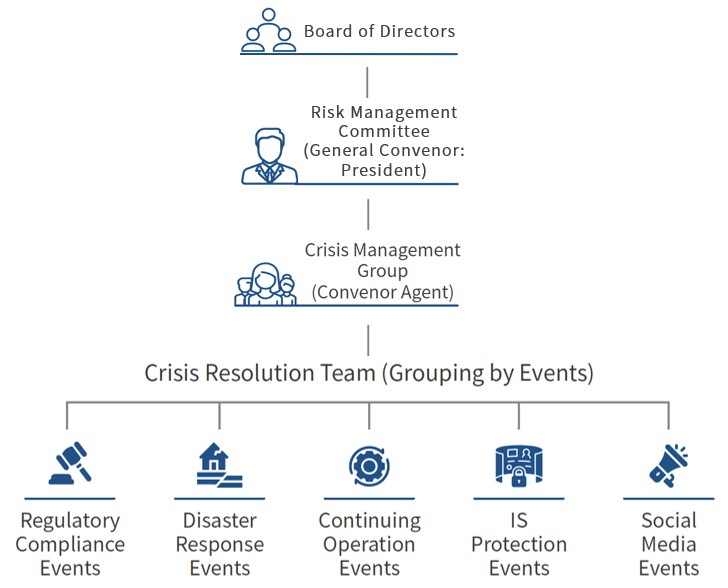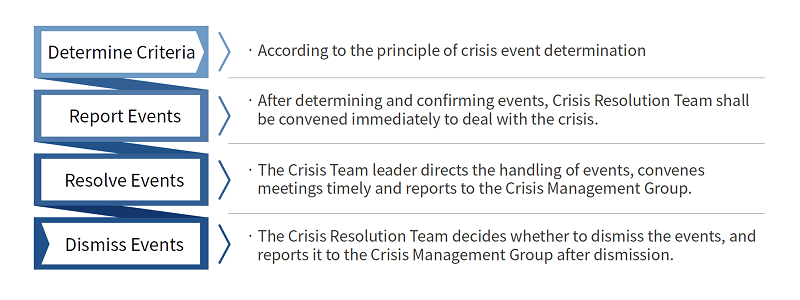Risk Management
In view of the global trend of emphasis on risk management, SYSTEX has improved the risk management mechanism to reduce the impact of risks, improve operational efficiency and corporate resilience in response to risks, and increase competitive advantages to implement sustainable operations. At the end of 2022, SYSTEX has established a cross-divisional Risk Management Committee under the Board of Directors, and formulated “Risk Management Best Practice Principles“, “Risk Management Policies and Procedures“, “Rules of Risk Management”, “Rules of Strategic Investment Management” and “Rules of Supervision and Management of Subsidiaries” to effectively control risks and improve management efficiency.
Risk Management Policy and Principle
|
Risk Management Goal
|
The SYSTEX Risk Management goals aim to consider and manage various risks that may affect the achievement of corporate goals through a complete risk management structure, and to achieve the following goals by integrating risk management into operational activities and daily management processes:
|
|
Risk Management Principle
|
|
Risk Management Organization
SYSTEX strengthens risk management with the Board of Directors as the highest governing body. A Risk Management Committee is established under the Board’s supervision to integrate risk management and supervision into daily activities and achieve sustainable operations.
Risk Management Organizational Structure

Board of Directors
As the highest governance unit for risk management of SYSTEX Group, the responsibilities of the board of directors are:
- Approve the “Risk Management Policies and Procedures” and risk management structures.
- Ensure that the operational strategic direction is consistent with risk management policies.
- Ensure that risk management mechanisms and risk management culture have been established.
- Supervise and ensure the effective operation of the overall risk management mechanism.
- Allocate and assign sufficient and appropriate resources to enable risk management to operate effectively.
Risk Management Committee
The Risk Management Committee executes risk management policies and reviews them periodically, and is accountable to the Board. They determine risk tolerance, prioritize risk management, and report on progress to the Board at least once a year or submit proposals for Board approval.
Crisis Management Group
The Crisis Management Group develops risk policies, procedures, and frameworks. They establish risk metrics and tolerance levels, analyze company risks, and oversee and coordinate risk management activities across departments. The Crisis Management Group is responsible for enhancing risk awareness among the entire organization with training programs. The Group is consisted of a number of functional division head of “Financial Division, Business Management Division, Legal Division, HR Division, Data & Info. R&D Division and BU/BI”. As a result, the Crisis Management Group held a meeting quarterly, with a total of 4 meetings in 2023.
Crisis Resolution Team
The Crisis Management Group has set up the Crisis Resolution Teams, grouping by crisis events. These teams are immediately activated when a crisis may occur, and are responsible for identifying the main causes of the crisis and dealing with the situation according to the “Rules of Risk Management.”
| Team | Person in Charge | Leader | Responsibility |
| Regulatory Compliance | Supreme head of Legal Division | Legal Division head or his assignee |
|
| Continuing Operations | Supreme head of BI | BI head or his assignee |
|
| Disaster Response | Supreme head of HR Division | HR Division head or his assignee |
|
| Information Security Protection | Supreme head of Data & Info. R&D Division | Data & Info. R&D Division head or his assignee |
|
| Social Media | Supreme head of Marketing & PR Division | Marketing & PR Division head or his assignee |
|
Crisis Management Procedures

Risk Trends and Material Issues
According to the WEF’s “Global Risk Report 2024”, half of the world’s top 10 long-term risks are related to the environment, including “Extreme climate events”, “Critical changes to Earth systems”, “Biodiversity loss and ecosystem collapse”, “Natural resource shortages” and “Pollution”; while the other three are technological risks, including “Misinformation and disinformation”, “Adverse outcomes of AI technologies” and “Cyber insecurity”. At the same time, considering employees is the core competitiveness of SYSTEX Group, and risk issues closely related to employees are also of great concern to SYSTEX. Therefore, SYSTEX has planed and formulated risk mitigation measures and management actions for “climate change risks”, “information security risks”, “human rights risks” and “health risks”.
For more details on these risks, please click the following links:

